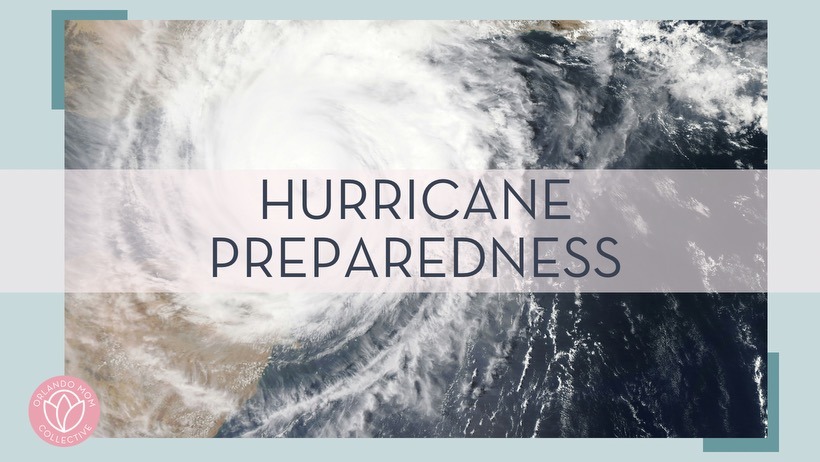Hurricane Preparedness

As a native Floridian that has experienced countless storms, including Hurricane Andrew (a Cat. 5), I can tell you that I still get nervous when a storm is a Cat. 3 and higher.
Here are some great tips to get prepped for your first storm or your 20th.
Here’s the roadmap for Hurricane Preparedness…
- We’ll explain hurricane terms you should know.
- We’ll share how to prepare.
- We’ll discuss what to do when the storm has passed.
So, what is a hurricane? Where can predictions be found?
Hurricanes, also called typhoons, are storm systems that form when warm ocean water combines with consistent low wind. There is a hurricane “season” because the sun doesn’t heat the entire earth evenly all the time, causing pockets of increased temperature differences at certain times of the year.
Learn how to keep your home and family safe this hurricane season
In the U.S., hurricane season runs from June 1 to November 30, but peaks between August and October. An average season includes 12 named storms, six hurricanes, and three major hurricanes.
Some of the most common vocabulary to keep top of mind during hurricane season is:
- Wind Scale. Hurricanes are measured on the Saffir-Simpson Wind Scale which ranks them from category 1-5 based on wind speed.
- Named Storm. Storms are named by the World Meteorological Organization when wind speeds reach 39 mph or higher.
- Tropical Storm. Tropical cyclones are reclassified as tropical storms and given a name when sustained wind speed is between 39 mph and 73 mph.
- Hurricane. Tropical storms are reclassified as hurricanes when they reach a wind speed of 74 mph or higher.
- Major Hurricane. A hurricane is reclassified as a major hurricane when it reaches wind speeds of 111 mph or higher, meaning it falls into categories 3-5 on the wind scale.
- Hurricane Watch. This means that an area might see hurricane conditions with winds of 74 mph or higher.
- Hurricane Warning. More severe than a watch, a warning announcement means an area is expected to experience hurricane conditions with winds of 74 mph or higher.
- The National Oceanic and Atmospheric Administration (NOAA) tracks storms in the National Hurricane Center. This is where advisories and watches are first announced, though you can also hear them during weather forecasts on local news and radio stations.
Preparing your home: early preparations
Hurricane preparation begins long before storm season. When it comes to your house, surviving the next storm depends greatly on hurricane-safe construction and upgrades.
One of the biggest hurricane dangers is flooding, as it can quickly damage belongings as well as the structure of the house itself. To prevent this, take a good look at your windows. Prioritizing long-term solutions over short-term saves. For example, it is better to invest in storm shutters and impact resistant windows instead of temporary plywood boards.
Protect your home from hurricanes this season.
There are, however, a couple things to keep in mind when deciding which hurricane-safe home improvements to take on.
The bottom line? “Once a window becomes compromised, there is a very good chance that the entire home will be destroyed,” Kolodny warned. Other recommendations from the Fox Insurance experts are installing garage door braces and roof straps, trimming trees, and using a power surge protector.
All of this said, there are a few things you can’t do until just before the storm arrives. This includes bringing outdoor furniture inside or tying it down, unplugging appliances, and turning off those surge protectors. The more you can do in advance, the more time you’ll have to devote to these small details and, more importantly, getting your family ready for impact.
Preparing your family: get on the same page
Much like preparing your home, the best way to prepare your family for a storm is well in advance. The first thing you’ll want to do is designate a safe room. Whatever room you choose should:
- Be an interior room
- Have limited or no windows
- Be large enough for all family members
- Often, closets, or bathrooms are a good choice. Basements may also work but could be more prone to flooding. Make sure all family members agree on the safe room and know where it is.
The next thing you’ll need to do is work on your emergency kit.
This includes everything you’ll want to have with you in the event of a storm that could last multiple days:
- Water
- Non-perishable food
- Chargers and batteries
- Radios and cell phone
- First aid supplies and medicine
- Clothing
- Flashlights
- Medications
Keep in mind that your emergency kit is everything you need to survive (like a 72 hour kit), but you can certainly add other things to your safe room to make it more comfortable. Depending on your family, you may want non-electronic toys, games, books, or even a mattress – good for comfort as well as protection. See a full list of emergency supplies on Ready.gov.
If the storm or storms begin to pose a significant danger, local officials may order an evacuation before it hits. If so, you’ll want to make sure you’re prepared. Decide on a meeting spot in case cellphones are not working or not with you. Fuel up the car in advance to avoid a low tank.
You’ll want to take your emergency kit, electronics chargers, IDs, cash, and any other essentials. If you have time, unplug appliances and grab small, sentimental objects to bring with you. In certain circumstances, you may want to turn off your gas, water, and electricity.
Of course, leaving is only the first step. You’ll also need a place to stay. Arrange in advance if you can to stay with family or friends. Alternatively, local radio and TV stations will broadcast assistance options. Remember that many public shelters do not accept pets.
Keep in mind that many disaster-prone areas have designated evacuation zones to streamline the evacuation process. You can find yours by looking up “Know Your Zone”.
Preparing your pets: plan for furry family members
85 million families in the U.S. own at least one pet, so humans might not be the only family members you have to think about in the event of a storm.
Families should prepare at least seven days’ worth of supplies for their pets.
This includes:
- Food
- Water
- Medications
- Beds and blankets
- Towels
- Crates and carriers
- First aid kit
- Collars with owner information
“Hurricane planning is about being prepared”
Additionally, pet owners will want to gather all records – medical, licensing, and microchip included. Keep in mind that details on a cell phone only work until the phone runs out of battery power. Finally, (this goes without saying….but) make sure to bring pets inside if a hurricane is approaching.
Recap
- The hurricane season in the U.S. peaks between August and October, but officially extends from June to November.
- Windows are your home’s weakest link – invest in hurricane shutters or glass to protect structural integrity.
- An emergency kit, a safe room, and an evacuation plan are the biggest factors in preparing your family for a storm.
- Don’t forget your pets! Gather their emergency supplies too and be ready to evacuate with them.
- Hurricane preparation resources
- Florida has enacted sales tax holidays on essential hurricane supplies before or at the beginning of hurricane season for the past few years. These kinds of measures are likely to continue as the threat of storms increases in coming years.
Additionally, there are many online resources that cover everything from emergency kit supplies to using technology to your advantage. In 2020, the American Red Cross partnered with education company GroovyTek to offer hurricane preparedness seminars on:
- Social media safety checks, helpful apps, Zoom, and other communication tools
- Devices, charging options, hotspots, and other technology resources
- Storing important documents, doorbell cameras, bank access, and other security concerns
- Disaster kit preparation for evacuation
- These seminars will remain available online as GroovyTek and the Red Cross expand offerings in future years.
Federal Emergency Management Agency (FEMA) offers an app for Android and iOS devices with real-time weather alerts, safety tips, and lists of open shelters in your area.
What should I do when a hurricane hits?
Whether evacuating or staying at home, there are a few things to keep in mind when the storm reaches your area.
If you are at home, gather all family members and go to your safe room. Stay there, and away from windows, until you get an all-clear report from local authorities. Keep track of reports and guidelines – they may change as the storm evolves and you’ll need to be prepared if ordered to leave. If you are ordered to leave, do so immediately and avoid flooded roads and deep water. The best place for your pets is with you, if possible.
The most important thing to remember regardless of your circumstance is to follow instructions from emergency workers. They are there to keep you safe and will have the most accurate information about what you should do.
How can I get back on track after the storm?
Before you venture outside or return home, make sure there is an official all-clear for the area, even if it sounds calm. Once you are sure it is safe, proceed cautiously.
When walking outside, be on high alert. Pay attention to any smells of gas and look out for broken glass and water, even if it’s as small as a puddle.
When you know it’s safe to move around your home, clean the gutters and remove hurricane shutters as needed. Additionally, FEMA recommends throwing out food, disinfecting your belongings, and not drinking tap water.
Remember that returning to normal will take time.
Content from ChooseEnergy.com




















